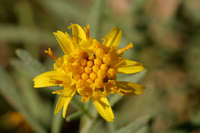Perennials, 3-20+ cm (± rhizomatous, sometimes forming colonies). Stems ± erect or spreading, branched ± throughout. Leaves cauline; all or mostly opposite; petiolate or sessile; blades mostly ternately lobed (blades or lobes lanceolate to lance-linear), ultimate margins entire, faces sparsely to densely scabrellous (hairs white, straight, conic or fusiform, 0.1-0.4 mm) and gland-dotted. Heads radiate, borne singly or (3-6) in loose, corymbiform arrays. Involucres turbinate or obconic to ± hemispheric, 5-6+ mm diam. Phyllaries persistent, 6-10 in 1-2 series (reflexed in fruit, distinct, oblanceolate, subequal, herbaceous, margins membranous, not purplish). Receptacles ± convex, ± pitted, epaleate. Ray florets 3-8, pistillate, fertile; corollas usually yellow, sometimes ochroleucous. Disc florets 20-40+, bisexual, fertile; corollas yellow to orange (gland-dotted), tubes about equaling funnelform to campanulate throats, lobes 5, deltate to lance-deltate. Cypselae narrowly obpyramidal, 4-angled, finely nerved, shaggily hairy (at least at bases) and/or gland-dotted; pappi persistent, of 8-10 (distinct) ovate or elliptic to lanceolate or linear-subulate (basally and/or medially thickened, distally and/or laterally scarious) scales in 1 series (weakly, if at all, aristate). x = 12.
According to T. F. Stuessy et al. (1973), among others, Picradeniopsis is closely allied to Bahia. Indeed, the species are often treated as members of Bahia. Where they occur together, the two species of Picradeniopsis may produce more or less sterile hybrids.





